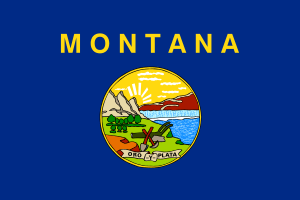Montana State Government facts for kids
The government of the State of Montana is set up by the Montana Constitution. It has three main parts, called branches: the Executive, Judicial, and Legislative branches. This setup helps make sure no single part of the government has too much power. Also, people in Montana have the right to suggest new laws or vote on existing ones directly.
Montana's current state constitution was put in place in 1972. It made some important changes. For example, it says that everyone in Montana has a right to see how their government works. This means they can look at official papers and watch meetings of state groups and agencies.
Contents
Legislative Branch: Making Laws
Montana has a law-making group called the Montana State Legislature. It's like the U.S. government and many other states because it has two parts:
- The House of Representatives has 100 members.
- The Senate has 50 members.
People vote to choose who will be in the House and Senate. Since 1992, there have been rules about how long someone can serve. House members can serve up to four 2-year terms, and Senate members can serve up to two 4-year terms.
The Legislature usually meets only every other year, for about 90 days. But the governor can call them together for special meetings if needed.
Executive Branch: Carrying Out Laws
The Executive Branch is in charge of making sure Montana's laws are followed every day. The main leaders here are:
- The Governor (the top leader)
- The Lieutenant Governor (second in command)
- The Secretary of State
- The Attorney General
- The Superintendent of Public Instruction
- The State Auditor
These leaders, along with their teams, work in 14 main departments. These departments help run the state's daily business. The constitution says there can be no more than 20 main departments.
- Elected Executive Officials in Montana
What Do Executive Agencies Do?
Here are some of the important departments in Montana's Executive Branch and what they do:
- Administration: This department helps other state agencies with things like money, buildings, buying supplies, and managing state workers.
- Agriculture: They work to protect farmers and consumers. They also help grow Montana's farming businesses.
- Commerce: This group helps businesses and communities. They also promote Montana as a great place to visit or to film movies.
- Corrections: They manage the state's adult and youth correctional facilities. They also oversee people who are on probation or parole.
- Environmental Quality: Their job is to keep Montana's environment clean and healthy. They manage air and water quality laws and help clean up polluted areas.
- Fish, Wildlife and Parks: This department takes care of Montana's fish, wildlife, parks, and outdoor recreation areas. They also make sure people follow hunting, fishing, and park rules.
- Labor and Industry: They help manage programs for workers, like unemployment insurance. They also work to prevent unfair treatment in jobs and help people find work.
- Livestock: This department works to control animal diseases and protect the livestock industry from theft. They also keep an eye on horse racing in the state.
- Military Affairs: They oversee the Army and Air National Guard. They also help with disaster and emergency services.
- Natural Resources and Conservation: They promote good care of Montana's water, soil, forests, and rangelands. They also help fight wildfires.
- Public Health and Human Services: This is a large agency that helps people with many programs. These include health care, food assistance, and services for children, families, and older adults. They also work to protect public health.
- Revenue: This department collects state taxes and makes sure tax laws are followed. They also manage the rules for alcoholic beverages.
- Transportation: They are in charge of Montana's roads, bridges, and other transportation systems. They also work on highway safety.
Other Important Groups
The state government also has many other important groups, like boards, commissions, and councils. These groups help with specific tasks and give advice on different topics. Some examples include:
- Advisory Council on Aging
- Aeronautics Board
- Board of Crime Control
- Board of Environmental Review
- Board of Public Education
- Montana Lottery
- Public Service Commission
- State Tax Appeal Board
- Tourism Advisory Council
Judicial Branch: Interpreting Laws
The Judicial Branch is made up of courts that interpret laws and solve disagreements. The highest court in Montana is the Montana Supreme Court. This court hears cases about the state government and explains state laws and the state constitution.
Unlike many other states, Montana does not have a middle-level appeals court. This means the Supreme Court hears all appeals directly. The Supreme Court also handles other duties, like making rules for lawyers and judges. The Montana Water Court deals with issues related to water rights in the state.
The courts in Montana include:
- The Supreme Court (with a Chief Justice and six other Justices)
- The District Courts
- The Workers' Compensation Court
- The Water Court
- The Courts of Limited Jurisdiction, which are smaller local courts like Justice Courts and City Courts.
See also
- Montana Senate
- Montana State Legislature
- Montana State Capitol
- Montana Constitution





